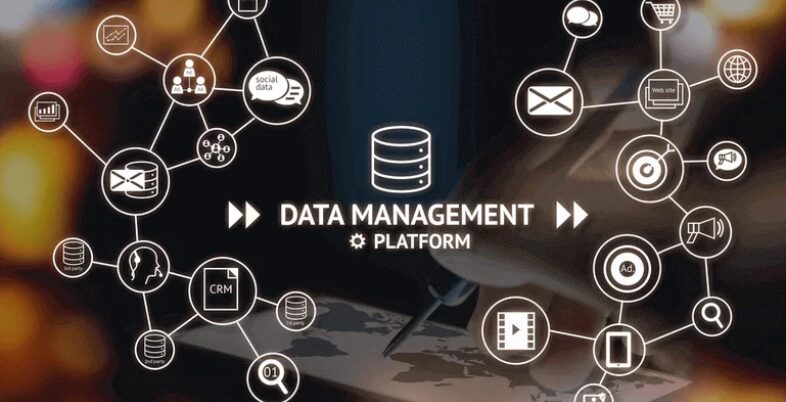Data Management Platforms (DMPs) help businesses centralize and make sense of vast amounts of customer information. In the current data-driven business environment, organizations are creating and amassing volumes of customer information like never before at many touchpoints. Whether it comes to interactions with websites and social media, buying histories, and habits, the volume of potential data available is both a great opportunity and a great challenge. DMPs are now a key component of the infrastructure that companies need to realize the potential of this information and be able to centralize fragmented data sources, build encompassing profiles of their customers, and make use of this data to run targeted marketing and advertising campaigns.
Customer data management and customer data utilization have become a competitive differentiator in all industries. When companies effectively adopt strong data management concepts, campaign performance is elevated, customer experiences are better, and their marketing initiatives are more profitable. The capabilities rely on DMPs that are the backbone of technology needed to convert raw data into practical business intelligence that promptly leads to growth and customer satisfaction.
What is a Data Management Platform (DMP)?
Data Management Platform is a unified technology platform that gathers, systematizes, and mobilizes vast amounts of both structured and unstructured data at a central location. DMPs are mostly interested in anonymous audience information, and they compile data about websites, mobile applications, social media networks, offline data, and information providers to derive detailed audience segments to use in marketing and advertising processes.
The major difference between Customer Data Platforms (CDPs) and DMPs is their main data focus and purposes. Although DMPs are effective at operating anonymous and cookie-based data to target audiences and activate advertising, CDPs focus on building customer profiles based on known personally identifiable information throughout the entire customer lifecycle. The main aim of DMPs is media buying, audience extension, and lookalike modeling, whereas the main aim of CDPs is a personalized customer experience and orchestration across the channels.
DMPs are most commonly used in programmatic advertising optimization, audience discovery and expansion, cross-device targeting, campaign performance measurement, and compliance with privacy regulations. DMPs help marketing teams to increase the relevance of ads, decrease media waste, and gain a higher ROI in their campaigns by allowing them to target their audience with precision and optimize their campaigns by the minute. Data Management Platforms (DMPs) enable businesses to leverage customer data for smarter marketing decisions.
Key Features to Look for in a DMP
1. Collected and Unified Data
An effective DMP must be able to easily absorb information of various types, such as first-party website and app data, second-party partner data, and third-party information providers. The platform should support different data types, such as structured data records in the database and unstructured social media engagements, and ensure that data quality and consistency remain consistent across all data sources. Data Management Platforms (DMPs) must be capable of seamlessly integrating multiple types of customer information for better insights.
2. Advanced Segmentation
Find advanced segmentation functionality that extends beyond basic demographic and geographic segmentation. The most efficient Data Management Software provide behavioral segmentation, predictive modeling, lookalike audience generation, and machine learning-based clustering that can find valuable patterns in the audience and areas to optimize the campaign.
3. Real-time Data Activation
The new DMP should be able to offer real-time data processing and activation features, so that they can target the audience instantly and optimize their campaigns. This involves the ability to connect to demand-side platforms (DSPs) and ad exchanges, among other programmatic advertising technologies, to execute campaigns in real-time.
4. Privacy and Compliance Features.
As data privacy turns into a subject of regulatory control, such essential features as GDPR and CCPA compliance tools, consent management integration, data retention controls, and transparent control over data governance will become a thing that can and probably will happen. The system must include audit trails and user rights management in order to be able to comply with regulations.
5. Integration Capabilities
It is essential to provide full integration support to marketing and advertising ecosystems, with native integrations to large ad servers, social media platforms, email marketing tools, analytics solutions, and customer relationship management systems. Pre-built connectors and API availability make implementation much easier and quicker to value.
Benefits of Using a Data Management Platform
1. Centralized Data Collection
Data Management Platforms (DMPs) remove data silos, forming a single source of all audience data, so the data quality and accessibility of this data are always the same across marketing teams. Such a centralization prevents duplications of efforts, enhances data management, and offers a holistic picture of audience trends and interests.
2. Enhanced Customer Insights
Aggregating data across multiple touchpoints, Data Management Platforms (DMPs) can provide a deeper insight into the audience, such as cross-device behavior patterns, content preferences, buy intentions, and engagement trends. Such insights can be used to make better marketing choices and strategies using facts as opposed to assumptions.
3. Improved Targeting and Personalization
Complex segmentation options allow narrowing down the audience so that the campaign can be successful and eliminate advertising wastage. It allows marketers to build very narrow segments within the audience, provide personalized messages, and optimize a campaign in real-time based on performance metrics and behavioral factors.
4. Regulatory Compliance
The privacy controls and compliance features are built in to ensure organizations can meet the changing regulatory needs without compromising on their marketing capabilities. Data Management Platforms (DMPs) offer consent management and data retention policy tools, as well as fulfill user rights without reducing the effectiveness of marketing.
5. Enhanced ROI Through Campaign Optimization
Continuous improvement of campaigns through real-time analytics and optimization allows achieving a better return on advertising spend. Data Management Platforms (DMPs) offer extensive performance data, attribution modeling, and self-driving optimization capabilities that optimize the effectiveness of marketing investments across all channels and touchpoints.
List of Top 10 Data Management Platforms
1. Adobe Audience Manager
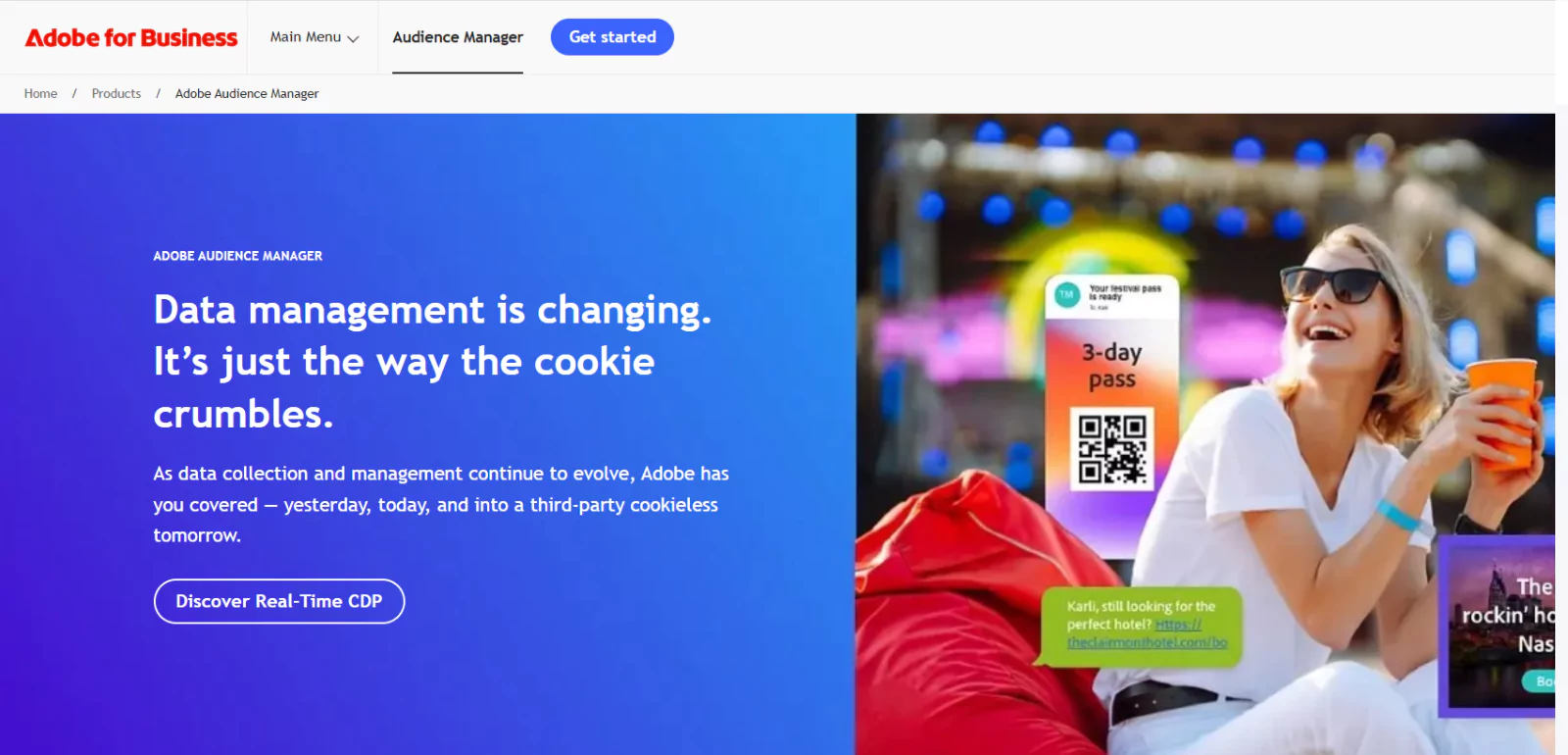
Adobe Audience Manager is a company-level DMP that is fully compatible with Adobe Experience Cloud. It is also the best at real-time audience segmentation, cross-device identity resolution, and predictive modeling using Adobe Sensei AI.
Marketers can enjoy the benefits of cutting-edge lookalike modeling, powerful reporting, and privacy controls. Well-suited to business, it provides high scalability and analytics. It, though, is more expensive and more complex and demands specific technical resources and a learning curve among those who are not familiar with the Adobe ecosystem.
Features
- Real-time audience segmentation
- Algorithmic and lookalike modeling
- Cross-device identity resolution
- Adobe Sensei AI-powered predictive capabilities
- Deep integration with Adobe Experience Cloud
Pros
- Strong Adobe ecosystem integration
- Enterprise scalability
- Advanced AI-driven insights
- Comprehensive reporting and analytics
- Built-in consent management for privacy compliance
Cons
- High pricing (best for enterprises)
- Requires dedicated technical resources
- Steep learning curve for new users
2. Oracle BlueKai
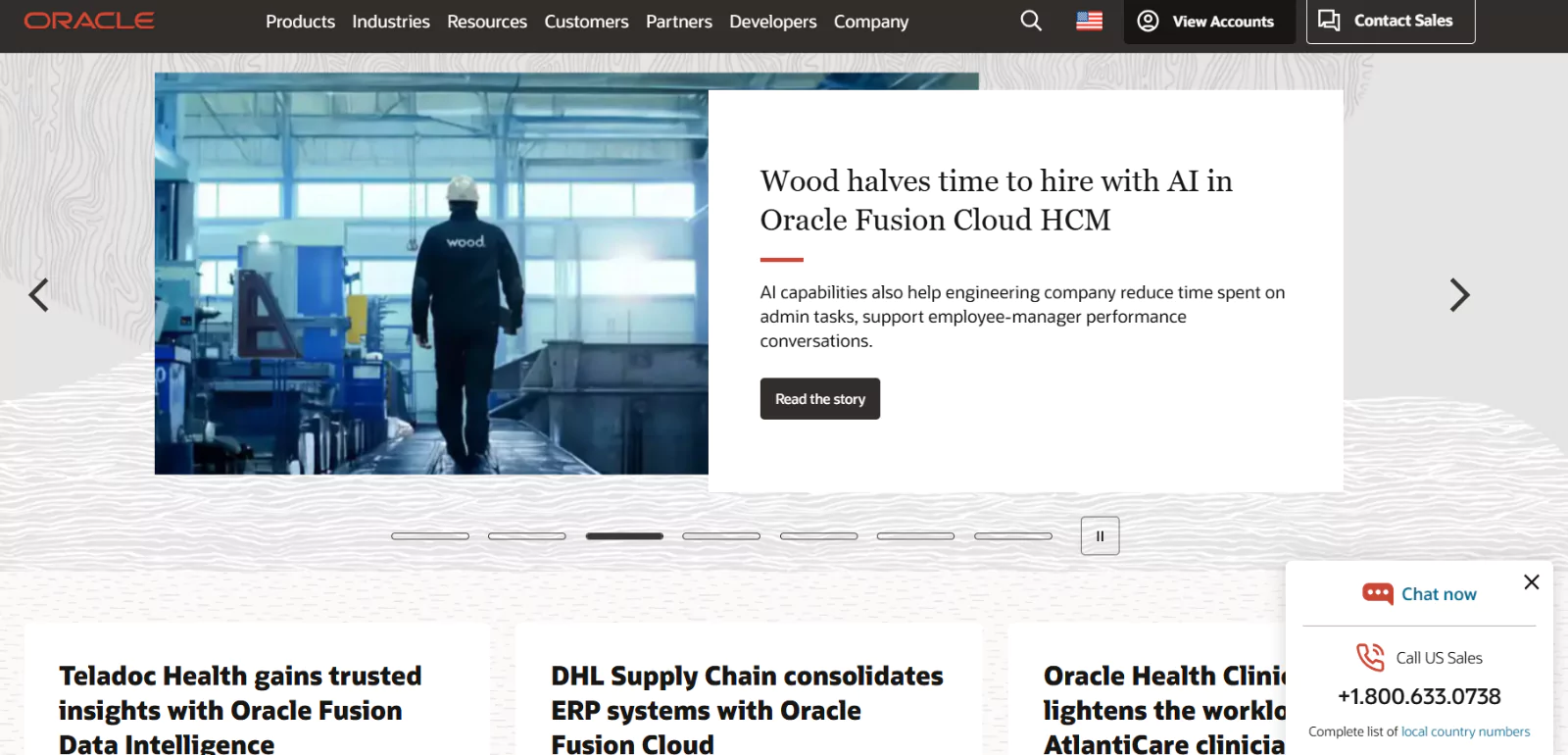
Oracle BlueKai is a mature DMP, a component of Oracle Data Cloud, providing access to one of the largest third-party data marketplaces in the world. It also provides powerful audience modeling, cross-device tracking, and cohesive integration with the Oracle Marketing Cloud.
BlueKai is reputed as a data quality and governance provider that is popular with business organizations. Its advantages are in its taxonomy management and audience insights, but it is complex to implement, expensive to maintain, and optimized best in the overall Oracle technology ecosystem, which makes it less adaptable to individual deployments.
Features
- Access to Oracle’s extensive data marketplace
- Advanced audience modeling and taxonomy management
- Cross-device tracking
- Strong integration with Oracle Marketing Cloud
- Data quality and governance controls
Pros
- Massive third-party data access
- Proven enterprise reliability
- Strong data governance features
- Seamless Oracle ecosystem integration
Cons
- Complex setup and implementation
- High total cost of ownership
- Best functionality tied to Oracle stack
3. Salesforce Audience Studio
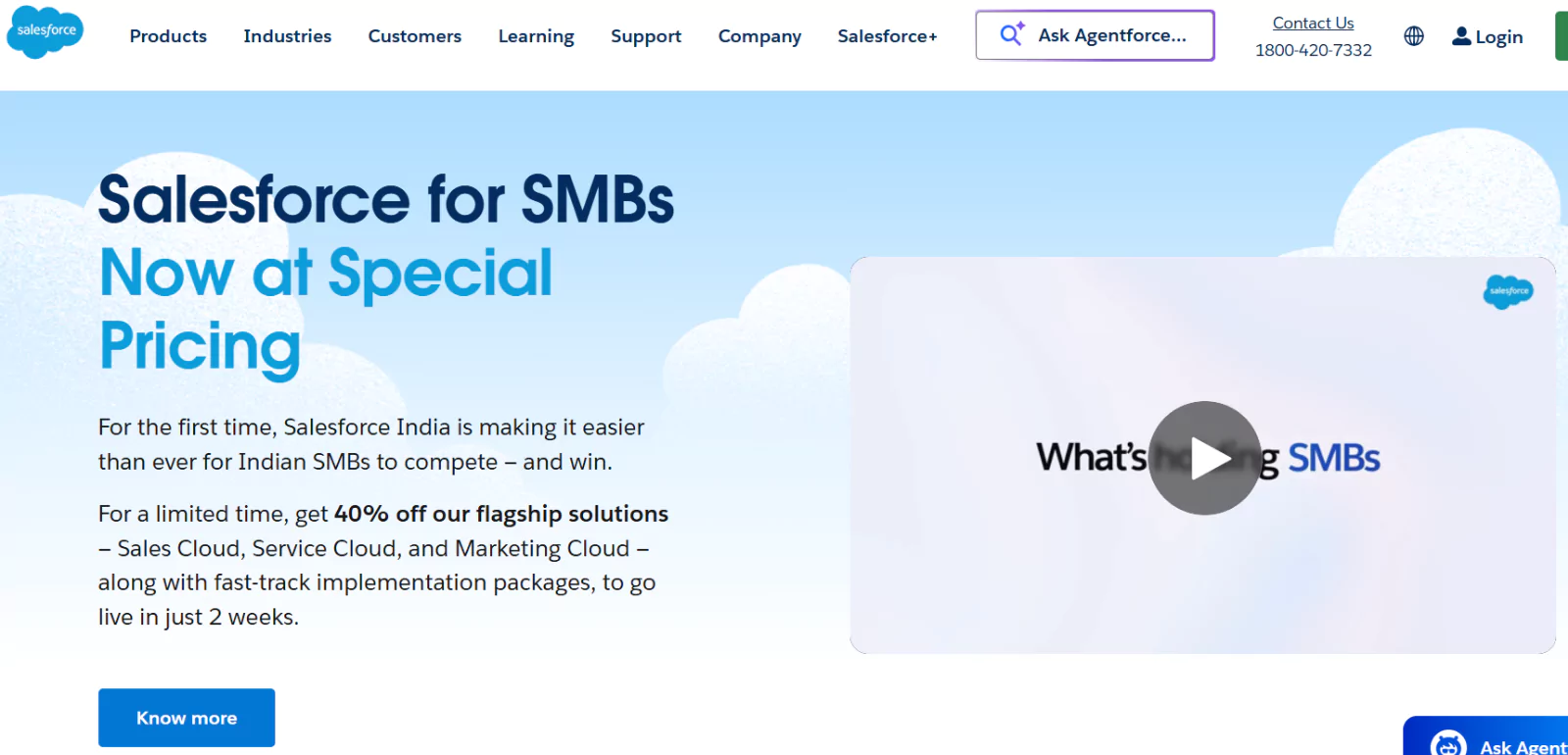
Audience Studio (previously Krux) is a cloud-based DMP designed with close integration to Salesforce Customer 360. It uses Einstein AI to provide insights on the audience, integrated mapping of customer journeys, and activation across channels. It is popular among businesses that are already a part of Salesforce due to its ease of use, mobile data collection, and rapid deployment.
However, it has some drawbacks, such as low accessibility to third-party data marketplaces, rising prices with data volumes, and diminished functionality when not used in conjunction with Salesforce’s portfolio of integrated marketing solutions.
Features
- Native Salesforce integration
- Einstein AI-powered insights
- Cross-channel activation
- Unified customer journey mapping
- Strong mobile app data collection
Pros
- Easy-to-use interface
- Quick deployment and implementation
- Excellent mobile capabilities
- Strong synergy with Salesforce ecosystem
- AI-powered recommendations
Cons
- Limited third-party data access
- Pricing scales with data volume
- Restricted outside Salesforce ecosystem
4. Lotame
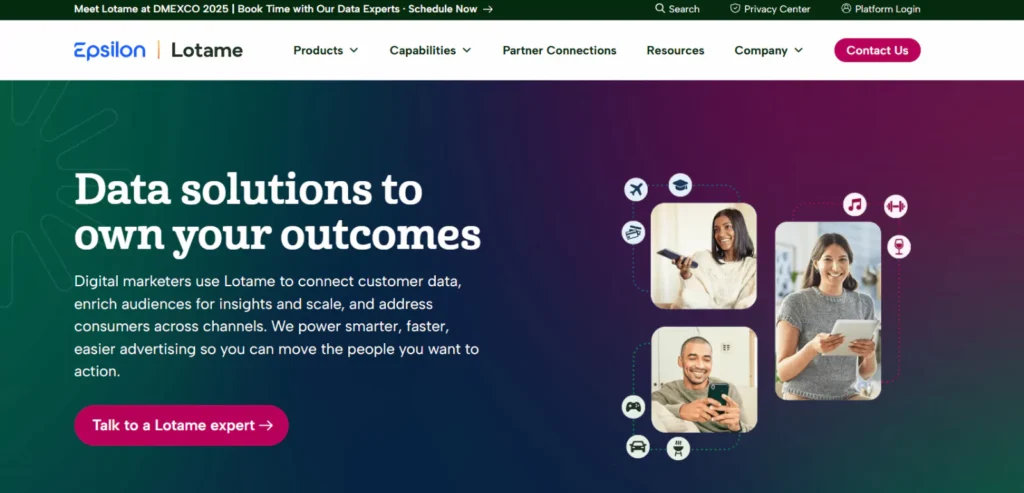
Lotame is a vendor-neutral, mid-market, and enterprise DMP. It includes Panorama ID, which identifies cookie-less identities, wide integrations, and first-party data activation. Companies like its competitive pricing, quality customer service, and its focus on privacy-first technologies.
Lotame is not tied to larger ecosystems, which allows it to be adopted in a variety of technology stacks. But it has a lesser third-party data marketplace, fewer AI-driven functions, and might need more tools to support more complex enterprise needs. It’s a solution that appeals to those companies that put a lot of emphasis on flexibility and affordability.
Features
- Panorama ID for cookieless identity resolution
- Wide integration marketplace
- Flexible data activation
- Audience analytics tools
- Strong focus on first-party data
Pros
- Vendor-neutral and highly flexible
- Competitive pricing
- Great customer support
- Ahead in privacy-first solutions
Cons
- Smaller third-party data pool
- Limited advanced AI features
- May need add-ons for enterprise-scale needs
5. Nielsen DMP
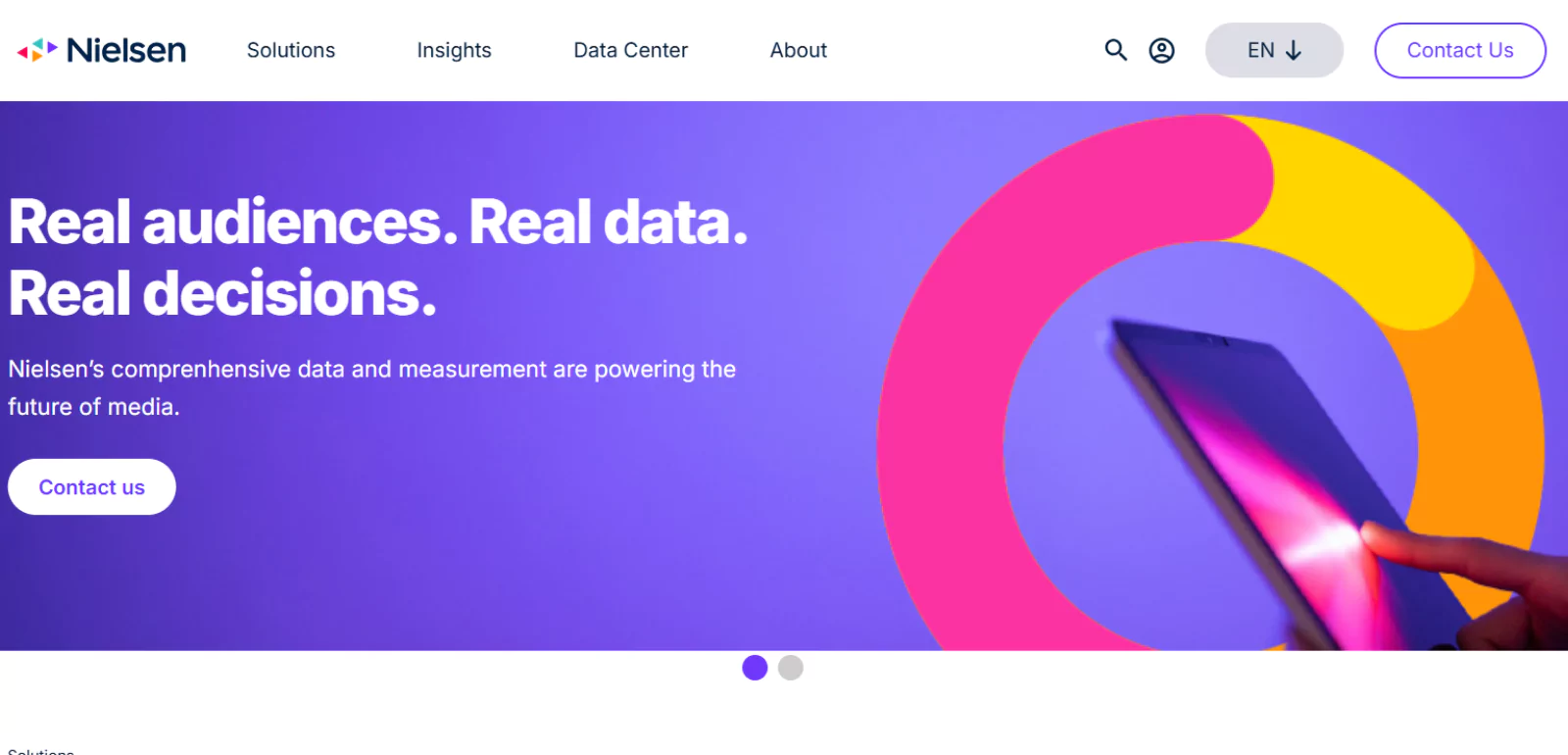
The DMP developed by Nielsen uses its audience measurement expertise, which is the best in the industry, to offer robust data integration online and offline. It allows cross-media planning, sophisticated attribution modeling, and higher-quality audience validation features. Companies can use Nielsen’s proprietary audience data to gain insight into the audience and ensure brand safety. Data Management Platforms (DMPs) like Nielsen leverage industry-leading audience measurement expertise for robust data integration.
Although it is outstanding in terms of media planning and measuring accuracy, the platform is very costly and difficult to use. Most applicable to businesses with multi-channel campaigns, it might be overkill when needed by the less complex and cost-efficient DMP systems in digital-only businesses. Data Management Platforms (DMPs) can offer high precision in media planning but may not suit all business sizes.
Features
- Proprietary Nielsen audience data
- Cross-media planning capabilities
- Advanced attribution modeling
- Offline and online data integration
- Strong brand safety and verification tools
Pros
- Premium measurement and insights access
- Strong offline data integration
- Excellent verification and safety features
- Comprehensive planning tools
Cons
- Expensive due to premium data
- Complex implementation and management
- Overkill for digital-only businesses
6. SAS Data Management

SAS Data Management integrates thousands of years of analytics knowledge and DMP features, so it is optimal when a company has complex data transformation requirements. It comes with a high level of statistical modeling, machine-based intelligence, robust data quality management, and scalable on-premise and cloud deployments. The platform is robust in controlled sectors where there is high security. Data Management Platforms (DMPs) like SAS Data Management excel in handling complex data transformation and advanced analytics.
But its high cost, complex implementation, and high prices prevent its use by small companies. SAS is the preferred vendor when the amount of data management required is heavy and has a high level of analytics. Data Management Platforms (DMPs) like SAS are best suited for organizations with heavy data management and advanced analytics needs.
Features
- Advanced statistical modeling
- Machine learning-powered insights
- Comprehensive data quality management
- On-premises and cloud deployment options
- Enterprise-grade security
Pros
- Extremely powerful analytics
- Excellent data quality controls
- Flexible deployment options
- Great for regulated industries
Cons
- Requires advanced technical skills
- High implementation complexity
- Expensive for smaller firms
7. OnAudience.com
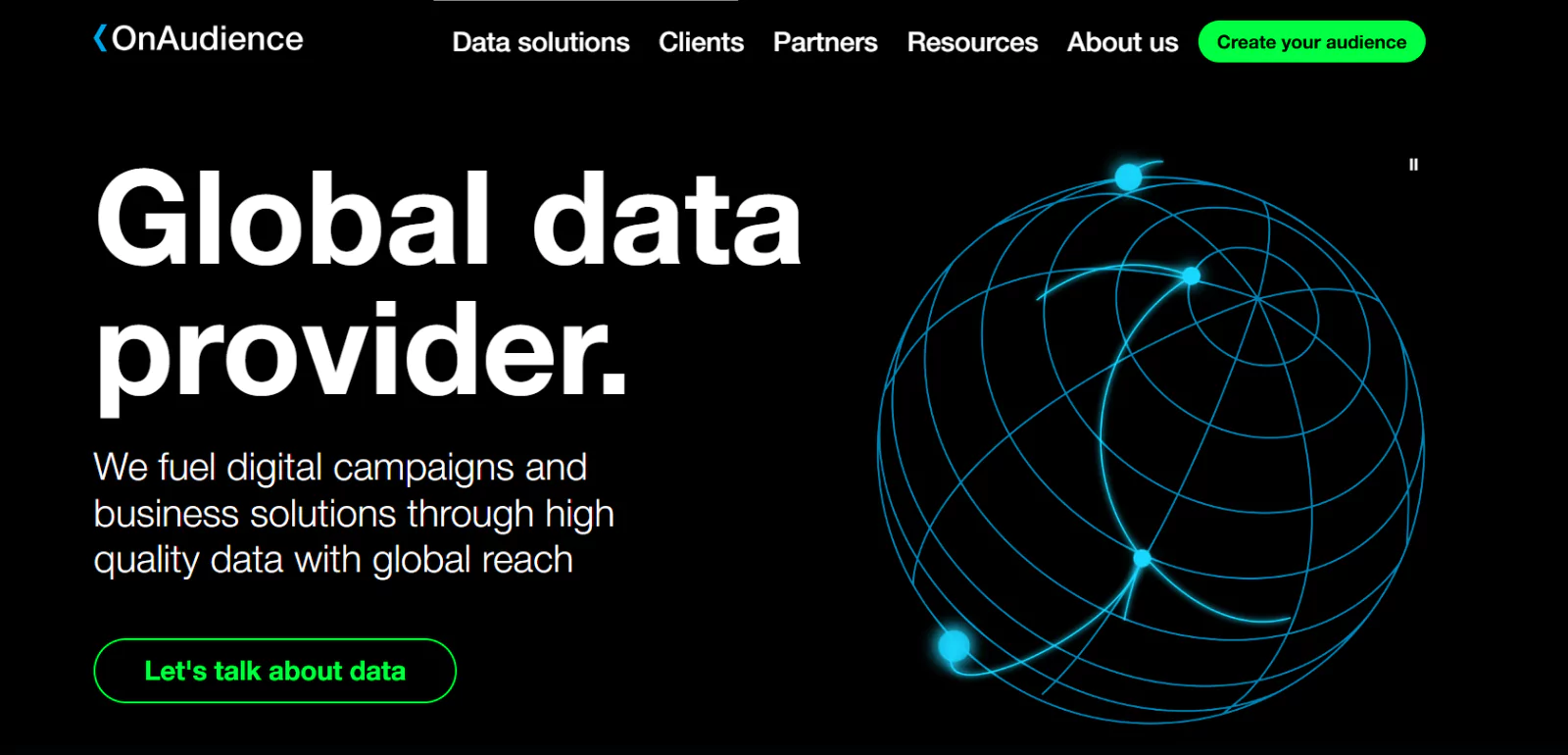
OnAudience.com is a DMP that is European-oriented and whose central value is GDPR compliance. It provides a European data marketplace access and user-friendly workflows, as well as powerful consent management capabilities. It is also reputed to have a competitive pricing approach and a regional level of customer services that focus on data privacy for the mid-market business. Data Management Platforms (DMPs) like OnAudience.com are designed with GDPR compliance and European market needs in mind.
Although it offers credible privacy-first information management, it has a limited scope of global reach, and it has lower levels of technologically advanced AI and machine learning than larger competitors. OnAudience.com is most appropriate for European companies that need compliant and cost-effective data management. Data Management Platforms (DMPs) like OnAudience.com provide privacy-first data management but have certain limitations.
Featues
- GDPR-compliant architecture
- European-focused data marketplace
- Simple audience creation workflows
- Strong consent management tools
- Localized support in Europe
Pros
- Excellent GDPR compliance
- Competitive pricing
- User-friendly with minimal training
- Local language customer support
Cons
- Limited global reach
- Smaller scale vs. major platforms
- Fewer advanced AI/ML features
8. Permutive
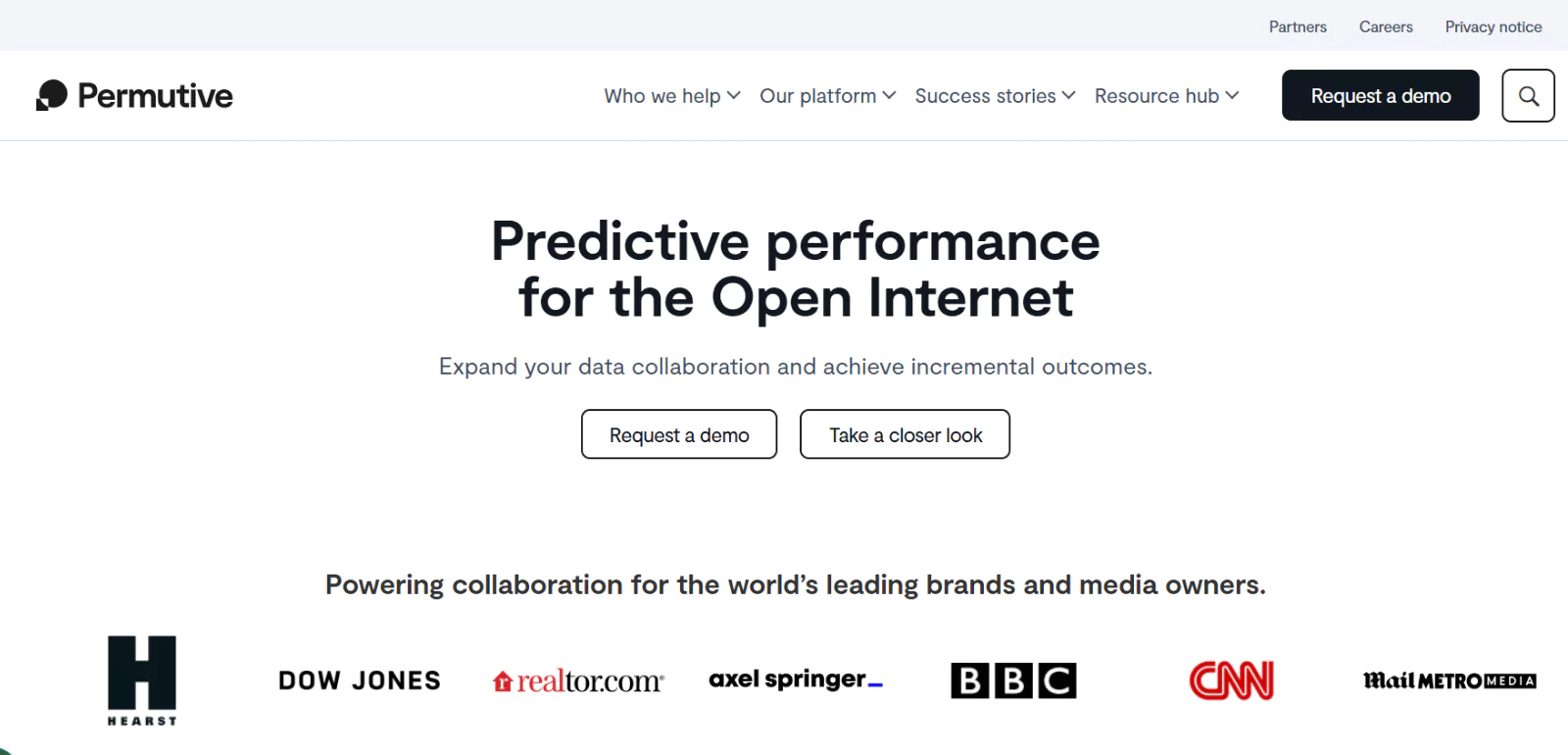
Permutive is a web privacy-focused, cookieless next-generation DMP. It applies edge computing to real-time data processing and specializes in publisher monetization and privacy-compliant audience targeting. It is used to do sophisticated cohort analysis on a user-by-user basis and is especially popular among media companies. Real-time features, innovative targeting, and high privacy are considered strengths. Data Management Platforms (DMPs) like Permutive focus on privacy and real-time audience targeting for publishers.
However, being a relatively new platform, it has not yet developed as many features as it could, and its concentration on publishing does not allow for more extensive enterprise usage. Permutive works well with publishers that are getting ready to go post-cookie. Data Management Platforms (DMPs) like Permutive can be effective but may have feature limitations for broader enterprise use.
Features
- Edge computing for real-time data
- Cookieless audience targeting
- Publisher monetization tools
- Cohort-based audience analysis
- Privacy-compliant by design
Pros
- Strong privacy-first technology
- Real-time data processing
- Great for publishers and media companies
- Cookieless future-proof targeting
Cons
- Newer platform with evolving features
- Niche focus on publishers/media
- Limited enterprise deployments
9. SAP Customer Data Platform
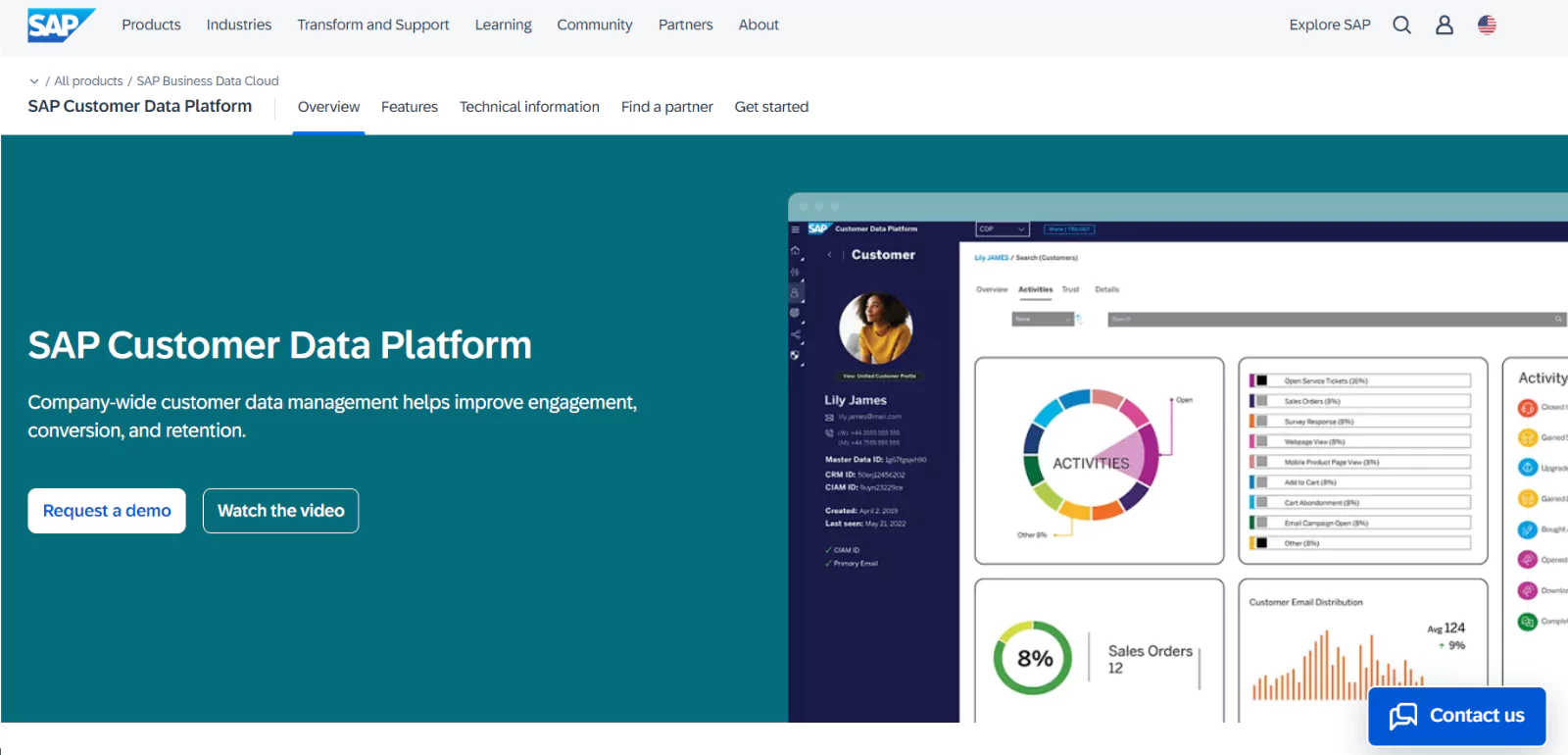
SAP Customer Data Platform is the extension of SAP enterprise software capabilities into customer experience management. It combines the functionality of DMP and CDP, provides integrated customer profiles, machine learning insights, and automation. The platform is deeply supported by the SAP ecosystem, which is why it helps to provide the full customer lifecycle with effective security and compliance. Data Management Platforms (DMPs) integrated with SAP CDP extend enterprise capabilities into customer experience management.
It is scalable to global deployments and would be attractive to a large enterprise. But it is complex, consumes too many resources, and is expensive to implement in a small organization. SAP CDP will help business that already uses the SAP enterprise solutions. Data Management Platforms (DMPs) should align with your organization’s size, resources, and existing systems.
Features
- Unified profiles for known + anonymous data
- Machine learning-powered insights
- SAP ecosystem integration
- Business process automation
- Global scalability and security
Pros
- Strong SAP enterprise integration
- Covers full customer lifecycle
- Robust compliance and security
- Scalable for global deployments
Cons
- Complex and resource-heavy setup
- Higher total cost of ownership
- Best suited if already using SAP stack
10. The Trade Desk DMP

The Trade Desk incorporates the DMP functionality with its programmatic advertising platform, which is why it is quite efficient in terms of programmatic advertising. It provides access to a large third-party marketplace of data, cross-device targeting, seamless audience creation, and attribution modelling. Real-time campaign activation and ROI oriented insights are beneficial to businesses. Data Management Software integrated with programmatic platforms can deliver powerful targeting and analytics capabilities.
Nonetheless, its operation is closely related to programmatic workflows, restricting independent DMP functionality. The Trade Desk is best optimized to serve advertisers and agencies with large-scale programmatic campaigns, but lacks flexibility outside of advertising applications. While Data Management Platforms (DMPs) offer powerful data management capabilities, their functionality can be context-dependent.
Features
- Native integration with Trade Desk DSP
- Large third-party data marketplace
- Cross-device targeting
- Advanced attribution modeling
- Streamlined campaign activation
Pros
- Perfect for programmatic advertising
- Excellent ROI measurement
- Large data marketplace access
- Efficient audience activation
Cons
- Programmatic advertising focus only
- Limited standalone DMP use
- Less suited for broader marketing needs
How to Choose the Right DMP for Your Business
When picking the most suitable Data Management Platforms (DMPs), a few key considerations must be factored in, which must be synchronized with the requirements of your organization, the technical capabilities, and the expansion plans of the organization. Begin with your data volume and complexity requirements assessment, which platforms are diverse in the capability needed to support multi-source and high-volume requirements of data integration and processing.
1. Scalability Considerations
Confirm the ability of each platform to scale with your business, including its data volume capacity, user capacity, geographic reach expansion capability, and load performance. Consider the requirements and future growth over the next 3-5 years to come and avoid costly system migrations. When selecting Data Management Platforms (DMPs), it’s crucial to confirm the platform’s ability to scale with your business.
2. Integration Requirements
Check compatibility with your existing marketing technology stack, which may include advertising tools, analytics tools, CRM tools, and email marketing tools. Priority should be given to platforms with native integrations with the most relevant parts of your system, since then such platforms will not require complicated implementation and maintenance. When evaluating Data Management Software, it is essential to check compatibility with your existing marketing technology stack.
3. The Compliance/Privacy Work Environment:
Given the evolving regulatory requirements, consider the privacy settings and consent management features, the data storage, and compliance reporting agencies of every platform. Consider your geographic markets and applicable regulations to the extent that you can address geographical compliance. When choosing Data Management Platforms (DMPs), it is critical to evaluate privacy and regulatory compliance features.
4. Pricing Structure/Total Cost of Ownership:
Compare the pricing models, data processing volume, user licensing, integration fee, and the cost of maintenance support. Determine the cost of implementation, training requirements, and potential customization expenses to be aware of the actual total cost of ownership, not just the cost of the base platforms. When evaluating Data Management Platforms (DMPs), it’s essential to consider the full spectrum of costs, not just the base platform price.
5. Vendor Support and Expertise:
Evaluate vendor support, implementation, training, and continuity of customer success program. Evaluate the financial health of the vendor, their platform development roadmap, and commitment to the new privacy technologies and industry standards. When selecting Data Management Platforms (DMPs), it’s crucial to assess both the platform and the vendor behind it.
Conclusion
Data Management Platforms (DMPs) are now essential resources in the business world that aim to move their customer data to greater heights in the face of an ever-complicated regulatory and technological situation. Each of the reviewed platforms has its own distinctive strengths and abilities that fit various organizational requirements, such as enterprise-scale implementations where a full ecosystem of integrations is needed or a narrower-purpose solution that can be specialized to address a particular task, such as programmatic advertising or publisher monetization.
The secret to successful DMP implementation is to have a clear understanding of your individual needs, compare platforms against specific criteria, and choose a solution that not only aligns with your existing needs but also sets your organization on the path of future development and technological advancement. With the industry trending toward privacy-first, AI-driven data management, the platforms receiving this advantage will be the ones that strike a balance between their potent power and user privacy protection and overall regulatory compliance. Data Management Software are most effective when tailored to your organization’s unique requirements and growth plans.
It is possible to start small with a pilot implementation to see the limits of the platform and its suitability with the organization before investing in large-scale implementation. The initial investment in the proper GMP choice and execution will accumulate returns in the form of better campaign results, customer understanding, and more efficient marketing investment distribution through all channels and customer touch points. Data Management Platforms (DMPs) allow organizations to test and optimize their strategies before full-scale adoption.
For businesses looking to implement DMPs effectively, working with specialized digital solution providers like 7K Network can help in setting up robust data systems, ensuring scalability, and integrating DMP capabilities into existing marketing technology stacks.
Frequently Asked Questions
1. What is the Distinction between DMP and CDP?
Data Management Platforms (DMPs) are used mainly to handle the anonymous audience data to support advertising and media purchasing, paying attention to the aggregation of third-party data and programmatic targeting. CDPs generate cohesive customer profiles with first-party data to be used to personalize marketing through the entire customer lifecycle. Data Management Software are the best in audience discovery and media activation, whereas CDPs are maximizing customer experience and retention.
2. What is the Cost of a DMP?
The prices of Data Management Platforms (DMPs) differ widely depending on the volume of data, functionalities, and the level of complexity of implementation. Basic solutions begin at approximately $1,000-5,000/mo, intermediate solutions lie between 10 and $50,000/mo, and custom enterprise solutions may be in the millions. There are other expenses, such as implementation, training, data charges, and support services.
3. Do I Require Technical knowledge to Operate a DMP?
The majority of contemporary Data Management Platforms (DMPs) have easy-to-use audience-building and campaign-triggering interfaces, though more advanced features usually need technical expertise. When comparing platforms, take into consideration what your team is capable of and what resources it has available. There are a lot of vendors who offer training programs and managed services to close the technical gaps.
4. What is the way Data Management Platforms (DMPs) Guarantee Data Privacy Compliance?
Continental Data Management Platforms (DMPs) such as consent management, data retention, user rights fulfilment, and audit trails are built into the leading Data Management Software. But the bottom line is that compliance falls to proper configuration and governance processes. Engage legal teams directly to support platform set-up in accordance with all relevant regulatory requirements.
5. Do Data Management Platforms (DMPs) have any Advantages for Small Businesses?
Yes, however, small businesses must look carefully at cost-benefit ratios and consider less complex solutions. Smart entry-level Data Management Platforms (DMPs) and integrated systems in the existing marketing systems can be capable of doing enough without the complexity and expense of the enterprise level. Pay attention to the platforms with evident ROI metrics and scalable pricing models.
